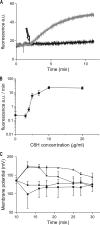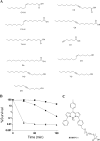Bactericidal activity of the human skin fatty acid cis-6-hexadecanoic acid on Staphylococcus aureus
- PMID: 24709265
- PMCID: PMC4068517
- DOI: 10.1128/AAC.01043-13
Bactericidal activity of the human skin fatty acid cis-6-hexadecanoic acid on Staphylococcus aureus
Abstract
Human skin fatty acids are a potent aspect of our innate defenses, giving surface protection against potentially invasive organisms. They provide an important parameter in determining the ecology of the skin microflora, and alterations can lead to increased colonization by pathogens such as Staphylococcus aureus. Harnessing skin fatty acids may also give a new avenue of exploration in the generation of control measures against drug-resistant organisms. Despite their importance, the mechanism(s) whereby skin fatty acids kill bacteria has remained largely elusive. Here, we describe an analysis of the bactericidal effects of the major human skin fatty acid cis-6-hexadecenoic acid (C6H) on the human commensal and pathogen S. aureus. Several C6H concentration-dependent mechanisms were found. At high concentrations, C6H swiftly kills cells associated with a general loss of membrane integrity. However, C6H still kills at lower concentrations, acting through disruption of the proton motive force, an increase in membrane fluidity, and its effects on electron transfer. The design of analogues with altered bactericidal effects has begun to determine the structural constraints on activity and paves the way for the rational design of new antistaphylococcal agents.
Copyright © 2014 Cartron et al.
Figures








Similar articles
-
In Vitro Antibacterial Activity of Unconjugated and Conjugated Bile Salts on Staphylococcus aureus.Front Microbiol. 2017 Aug 23;8:1581. doi: 10.3389/fmicb.2017.01581. eCollection 2017. Front Microbiol. 2017. PMID: 28878747 Free PMC article.
-
The effect of skin fatty acids on Staphylococcus aureus.Arch Microbiol. 2015 Mar;197(2):245-67. doi: 10.1007/s00203-014-1048-1. Epub 2014 Oct 18. Arch Microbiol. 2015. PMID: 25325933 Free PMC article.
-
The Staphylococcus aureus surface protein IsdA mediates resistance to innate defenses of human skin.Cell Host Microbe. 2007 May 17;1(3):199-212. doi: 10.1016/j.chom.2007.04.005. Cell Host Microbe. 2007. PMID: 18005699
-
Defective pgsA contributes to increased membrane fluidity and cell wall thickening in Staphylococcus aureus with high-level daptomycin resistance.mSphere. 2024 Jun 25;9(6):e0011524. doi: 10.1128/msphere.00115-24. Epub 2024 May 16. mSphere. 2024. PMID: 38752757 Free PMC article.
-
Antimicrobial proteins from snake venoms: direct bacterial damage and activation of innate immunity against Staphylococcus aureus skin infection.Curr Med Chem. 2011;18(33):5104-13. doi: 10.2174/092986711797636108. Curr Med Chem. 2011. PMID: 22050758 Review.
Cited by
-
GS-2: A Novel Broad-Spectrum Agent for Environmental Microbial Control.Biomolecules. 2022 Sep 13;12(9):1293. doi: 10.3390/biom12091293. Biomolecules. 2022. PMID: 36139131 Free PMC article.
-
Antimicrobial and antibiofilm effects of essential fatty acids against clinically isolated vancomycin-resistant Enterococcus faecium.Front Cell Infect Microbiol. 2023 Sep 29;13:1266674. doi: 10.3389/fcimb.2023.1266674. eCollection 2023. Front Cell Infect Microbiol. 2023. PMID: 37842001 Free PMC article.
-
Staphylococcus aureus Releases Proinflammatory Membrane Vesicles To Resist Antimicrobial Fatty Acids.mSphere. 2020 Sep 30;5(5):e00804-20. doi: 10.1128/mSphere.00804-20. mSphere. 2020. PMID: 32999082 Free PMC article.
-
Metabolomic profiling and bactericidal effect of Polyalthia longifolia (Sonn.) Twaites. stem bark against methicillin-resistant Staphylococcus aureus.Access Microbiol. 2023 Jun 29;5(6):acmi000432. doi: 10.1099/acmi.0.000432. eCollection 2023. Access Microbiol. 2023. PMID: 37424570 Free PMC article.
-
A Comprehensive Review on Chemical Structures and Bioactivities of Ostropomycetidae Lichens.J Fungi (Basel). 2025 May 9;11(5):369. doi: 10.3390/jof11050369. J Fungi (Basel). 2025. PMID: 40422703 Free PMC article. Review.
References
-
- Korting HC, Lukacs A, Braun-Falco O. 1988. Microbial flora and odor of the healthy human skin. Hautarzt 39:564–568 (In German.) - PubMed
Publication types
MeSH terms
Substances
Grants and funding
LinkOut - more resources
Full Text Sources
Other Literature Sources
Molecular Biology Databases

